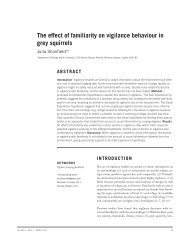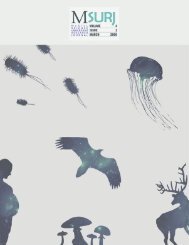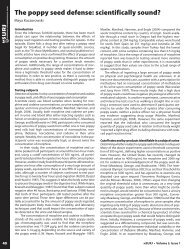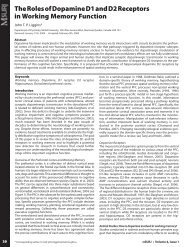the entire issue - McGill Science Undergraduate Research Journal ...
the entire issue - McGill Science Undergraduate Research Journal ...
the entire issue - McGill Science Undergraduate Research Journal ...
You also want an ePaper? Increase the reach of your titles
YUMPU automatically turns print PDFs into web optimized ePapers that Google loves.
Autosomal Recessive Spastic Ataxia of Charlevoix-Saguenay (ARSACS): a once obscure neurodegenerative disease with increasing significance for neurological research<br />
resides within <strong>the</strong> second SRR suggests that <strong>the</strong> function of <strong>the</strong> sacsin<br />
J-domain may require its interaction with SRR, whose ATPase activity<br />
may contribute to J-domain’s recruitment and stimulation of Hsp70.<br />
Finally, <strong>the</strong> 110-residue region at <strong>the</strong> very C-terminus of sacsin constitutes<br />
<strong>the</strong> higher eukaryotes and prokaryotes nucleotide-binding<br />
(HEPN) domain, first reported by Crynberg et al. in 2003 (48). As its<br />
name suggests, <strong>the</strong> HEPN domain is known to bind nucleotides and<br />
a number of HEPN domain-containing proteins, such as <strong>the</strong> kanamycin<br />
nucleotidyl transferase family proteins, which are implicated in<br />
bacterial antibiotic resistance (48). The ability of <strong>the</strong> HEPN domain of<br />
human sacsin to bind to various nucleotides (i.e. ATP, ADP, GTP, ADP<br />
and etc.) was verified by Kozlov et al. in 2011 via nuclear magnetic<br />
resonance (NMR) spectroscopy and iso<strong>the</strong>rmal titration calorimetry<br />
(ITC) (53). Crystal structure of <strong>the</strong> human sacsin-HEPN domain<br />
revealed that it exists as a dimer, which interacts with nucleotides<br />
electrostatically via a symmetric binding pocket formed at <strong>the</strong> dimer<br />
interface (53). The ARSACS-causing mutation N4549D at <strong>the</strong> dimer<br />
interface was shown to hinder <strong>the</strong> proper folding and <strong>the</strong> dimerization<br />
of <strong>the</strong> domain, which is likely responsible for its loss of function<br />
(53). Interestingly, <strong>the</strong> sacsin-HEPN domain did not exhibit any<br />
GTPase or ATPase activity (53) and many suggested that <strong>the</strong> sacsin<br />
HEPN domain most likely functions as an “energy stockroom” to<br />
supply nucleotides (particularly GTP and ATP) for sacsin’s chaperone-like<br />
activity (48, 53). However, <strong>the</strong>re is a lack of direct evidence<br />
demonstrating <strong>the</strong> utilization of <strong>the</strong> HEPN-recruited nucleotides by<br />
sacsin or its binding partners and <strong>the</strong> “energy stockroom” notion<br />
<strong>the</strong>refore remains largely <strong>the</strong>oretical.<br />
Fitting Toge<strong>the</strong>r Pieces of <strong>the</strong> Puzzle<br />
Experimental evidence accumulated to date strongly suggests that<br />
<strong>the</strong> sacsin protein functions as a Hsp40 family chaperone in neurons<br />
(54). The RegA region (N-terminal region of sacsin including<br />
UbL domain, <strong>the</strong> first SRR domain and <strong>the</strong> linker region preceding<br />
<strong>the</strong> second SRR domain) in human sacsin has been demonstrated to<br />
be capable of maintaining denatured firefly luciferase (FLuc, model<br />
protein-folding client in chaperone studies) in a soluble state and<br />
moderately facilitate its refolding independently from ATP, an activity<br />
characteristic of Hsp40 family chaperones (54). In addition, Reg A<br />
has been shown to be able to enhance <strong>the</strong> yield of <strong>the</strong> bacterial Hsp70<br />
chaperone system in <strong>the</strong> absence of DnaJ (49). This observation, in<br />
addition to <strong>the</strong> presence of a J-domain in <strong>the</strong> sacsin protein, signifies<br />
that <strong>the</strong> structure of sacsin is well-suited for delivering misfolded or<br />
denatured proteins to <strong>the</strong> Hsp70 system (54). In addition, siRNA studies<br />
demonstrated that sacsin is able to reduce <strong>the</strong> number and sizes<br />
of <strong>the</strong> insoluble nuclear ataxin-1 inclusion bodies (hallmark of many<br />
cerebellar ataxia disorders) in neurons and fur<strong>the</strong>r corroborated sacsin’s<br />
potential role as a neuronal chaperone (46).<br />
Recently, Girard et al. reported a transgenic sacsin-knockout (KO)<br />
mouse model that helped to elucidate several important aspects of<br />
<strong>the</strong> underlying pathogenic mechanism of ARSACS (8). The mouse<br />
model showed normal brain morphology and phenotypes (compared<br />
to control mice) at birth but displayed progressively decreasing<br />
number of Purkinje neurons from 120 days after birth, consistent<br />
with autopsy reports of significantly reduced number of Purkinje<br />
neurons in ARSACS patients (8). This observation confirmed agedependent<br />
Purkinje neuron degeneration as one of <strong>the</strong> main pathological<br />
features of ARSACS and excluded developmental causes from<br />
<strong>the</strong> etiology of <strong>the</strong> disease. In addition, immunofluorescence experiments<br />
revealed sacsin’s intracellular localization on <strong>the</strong> cytoplasmic<br />
side of mitochondria and small interference RNA (siRNA)-mediated<br />
knockdown of sacsin demonstrated remarkable changes in <strong>the</strong> morphology,<br />
function and transportation of mitochondria in sacsindeficient<br />
neurons (8). Fluorescence recovery after photobleaching<br />
(FRAP) confirmed that mitochondria in sacsin-knockdown cells are<br />
more elongated and interconnected, indicating defective mitochondrial<br />
fission; fluorescence measurement with tetramethylrhodamine<br />
methyl ester (TMRM) showed a significantly weaker membrane potentials<br />
of <strong>the</strong>se mitochondria, signifying diminished oxidative phosphorylation<br />
activity and ATP production (53). Immunofluorescence<br />
with mitochondrial marker in sacsin-knockdown neurons showed<br />
that <strong>the</strong> mitochondria in <strong>the</strong>se cells fail to be delivered effectively<br />
along <strong>the</strong> dendrites but cluster within <strong>the</strong> soma and <strong>the</strong> dendritic<br />
region proximal to <strong>the</strong> soma of <strong>the</strong> neurons (8). Fur<strong>the</strong>rmore, <strong>the</strong><br />
decrease in <strong>the</strong> number of dendrites as well as <strong>the</strong> thickened and disorganized<br />
morphology of <strong>the</strong> remaining dendrites in <strong>the</strong>se neurons<br />
suggest that <strong>the</strong> defect in mitochondrial transport had led to degeneration<br />
of <strong>the</strong>se neurons (8).<br />
Interestingly, dynamin-related protein 1 (Drp1), a GTPase crucial<br />
for mitochondrial fission, has been found to co-immunoprecipitate<br />
and partially colocalize with sacsin in neurons (8). In light of sacsin’s<br />
potential role as a molecular chaperone, Girard et al. suggested that<br />
sacsin most likely serves to maintain <strong>the</strong> properly-folded, functional<br />
conformation of Drp-1 ei<strong>the</strong>r directly or indirectly by recruiting<br />
<strong>the</strong> Hsp70 family chaperones (8). Absence of sacsin from cells would<br />
<strong>the</strong>refore increase <strong>the</strong> number of misfolded, dysfunctional Drp-1 and<br />
subsequent disruption of <strong>the</strong> fission/fusion dynamics of mitochondria.<br />
The ensuing impairments in mitochondrial function and transport<br />
would in turn result in degeneration of neurons (8). The effect<br />
would be particularly detrimental to Purkinje neurons, in which <strong>the</strong><br />
maintenance of extensively branched dendrites heavily depends <strong>the</strong><br />
energy produced by mitochondria as well as <strong>the</strong>ir ability to be transported<br />
effectively along <strong>the</strong> dendrites (35). The end-result would be<br />
impairments in <strong>the</strong> cerebellum’s ability to regulate and relay signals<br />
to <strong>the</strong> peripheries of <strong>the</strong> body, leading to a variety of sensory-motor<br />
symptoms such as those observed in ARSACS patients.<br />
Disruption in <strong>the</strong> mitochondrial fission/fusion dynamics is a common<br />
<strong>the</strong>me among many neurodegenerative diseases (9). In addition,<br />
Drp1 is suggested to be implicated in many of <strong>the</strong>se diseases as<br />
72<br />
<strong>McGill</strong> <strong>Science</strong> <strong>Undergraduate</strong> <strong>Research</strong> <strong>Journal</strong> - msurj.mcgill.ca









